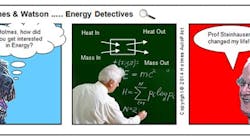Watson: How did you get interested in Energy and Thermodynamics, Holmes?
Holmes: In the fall of 1963, although I didn’t have a clue what an engineer did, I ended up as a freshman at Rose-Polytechnic Institute in Terre Haute, Indiana with about 180 others, most of whom didn’t have a clue either. It was an all male school and in four years when a little over 100 graduated, there were still a lot of us who still didn’t know what an engineer did in the Real World. Luckily during my sophomore year, I took Thermodynamics from Professor Steinhauser. After that, I knew I wanted to work with energy systems in buildings.
In the very first class he drew a rectangle on the board labeled “System”. He drew one arrow through one side of the rectangle pointed into it labeled “Heat In” and another pointed out labeled “Heat Out”. He then uttered words that changed my life; “Heat In Equals Heat Out”.
He was a great teacher, genuine nice guy and everybody loved him. But as I sat there with everything making such perfect sense and seeming so simple, I could hear all of the groaning from my fellow students. Most of them walked out after class not having understood a single word he said. It was a flunk-out course. Every week there were fewer students. I was just lucky; I had an aptitude. I guess I turned out to be kind of a Thermodynamics Savant.
Watson: “Savant.” Isn’t that someone with a limited IQ but an unusual talent in one area?
Holmes: Yep. That’s me. I was really fortunate I took that first class from “Stinky Bob” as the students fondly nicknamed him for the nasty smelling cigars he smoked. He had a special ability to simplify very complex material and was voted “Teacher of the Year” more than once. He got me interested in energy which eventually led to my interest in energy systems, first in airplanes and later in buildings.
I have spent my entire career working with energy systems, energy consumption, energy transformation, energy flows, energy conservation, heat transfer and fluid flow. First in jet engines and later with boilers, chillers, air compressors, HVAC systems and more in all types of facilities from schools and hospitals to industrial plants owned by some of the largest companies in the world. I even taught thermodynamics and other related classes early in my career for Purdue.
Watson: Okay. You learned “Heat In Equals Heat Out”. What about all of the complex math and other things you learned?
Holmes: All of the energy systems I have ever worked with operate according to what I learned from Prof Steinhauser in that very first class. “Heat In Equals Heat Out”, The First Law of Thermodynamics; and as I learned later in his class, all of the energy systems operate according to one other fundamental principle, “Mass In Equals Mass Out”. Believe or not, combined with other things I learned in school, some common sense and actual field experience, I have used those two principles to understand and solve every problem I have every encountered in the Real World.
Watson: “Heat In Equals Heat Out”, isn’t that common knowledge among Energy Professionals?
Holmes: Unfortunately, I have found very few people during my entire career in the Energy Profession who really understand those two most fundamental principles; not people out in the field working with the systems, and certainly not many of those selling solutions to owners. Most resort to very basic and simple tasks; many already have a solution when they walk in the door regardless of what the problem is. Even though they don’t really understand how a complex piece of equipment works, they can sell a new one and guarantee how much it will save, recommend new lights, do an audit or provide a cookbook list of common sense possibilities that the owner had already thought of.
There is a tremendous need for increased, practical and effective Energy Education that combines both the Theory with actual Real World experience. We need more people who understand the theory and can apply it in the field, people who understand that “Heat In Equals Heat Out” and “Mass In Equals Mass Out”.
Watson: I read in one of your articles, How to Quickly Lose the Single Greatest Opportunity to Increase Profits, that you tried telling some thermodynamics jokes in a bar in Madison, Wisconsin when you were teaching up there. How did that work for you?
Holmes: Let’s just say they weren’t as big a hit as the wet tee shirt contest.
Tell us about your experiences, both good and bad with energy professionals, what has worked and what hasn’t. Send us your comments, thoughts and suggestions on how to improve our profession so we can all continue to learn from each other. Thanks – Holmes & Watson.

